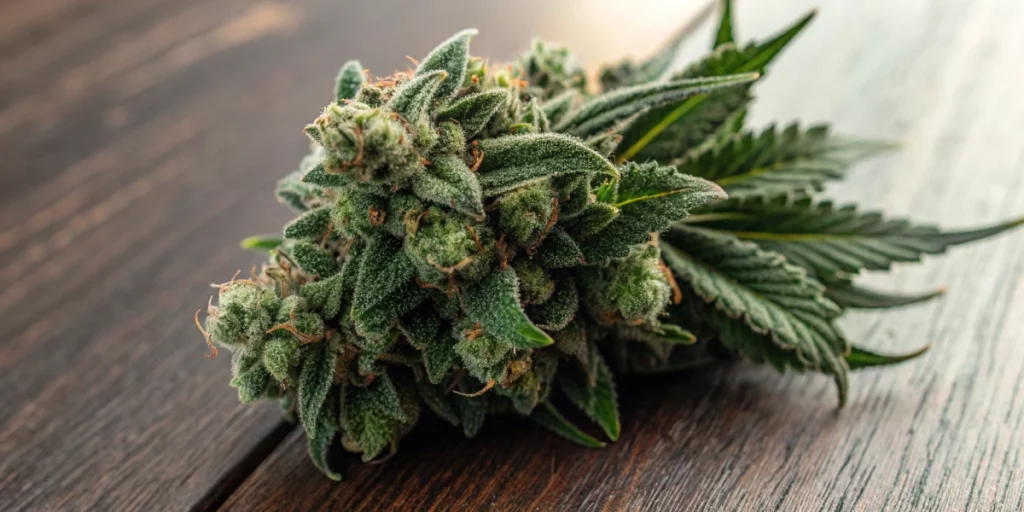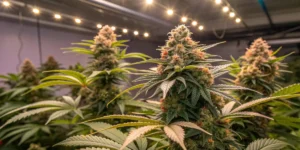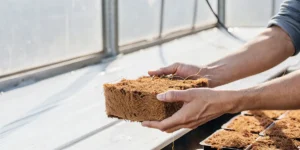Have you ever dreamed of a plant that finishes flowering quickly, fills your room with sweet aromas and rewards you with frosty buds in eight weeks? Picture trimming sticky flowers while the scent of citrus and spice drifts around you—this article will show you exactly how to achieve that dream with Kali Dog strain.
Kali Dog strain: Exceptional Genetics and Effects
Origins and Genetics
Kali Dog strain owes its birth to a breeder’s quest for a fast, potent plant. By crossing an Afghan landrace known for heavy resin with a sativa-dominant variety prized for uplifting effects, they created seeds that flower in eight weeks yet still pack power. Each generation was selected for uniform height, sturdy stems and dense bud structure, ensuring plants stay compact and manageable.
In early trials, breeders recorded germination rates above 95% and tracked flowering times, refining the mix until every seed reliably finished on schedule. The result is a strain that suits both closet growers and open-air gardens. Kali Dog strain’s genetics favor broad leaves that capture light efficiently and long internodes that allow airflow, reducing pest risks.
Effects and Potency
From the first inhalation, Kali Dog strain delivers a gentle cerebral tingle that lifts mood without racing thoughts. THC levels typically range from 18% to 21%, offering enough strength for stress relief yet leaving you clear-headed. Users often note a subtle energy boost followed by soothing body calm—ideal for creative projects or social gatherings.
Terpene profiles lean toward pinene and limonene, giving fresh pine and lemon peel scents with hints of earth. On the palate, you’ll taste spicy citrus with a sweet finish. These flavors linger on the tongue, making each session memorable. Extract enthusiasts prize the sticky trichomes for producing high-quality concentrates.
Environmental Requirements for Growing Kali Dog strain
Setting Up the Growing Cannabis Space
Choose a grow area that provides one to two square meters per plant. Line the walls with reflective Mylar or white paint to bounce every photon back to lower bud sites. Install an inline exhaust fan at canopy level to extract heat, paired with a passive intake vent down low to draw in fresh air.
Position oscillating fans to create gentle, constant airflow around the canopy. This movement strengthens stems and deters mold. Keep the area spotless—remove dead leaves and sanitize tools between uses. A digital timer on lights prevents human error, ensuring Kali Dog strain follows a strict light schedule.
Temperature and Humidity
Aim for daytime highs of 22–26 °C and nighttime lows around 18 °C. In the vegetative phase, keep humidity between 50% and 60% to support leaf growth; then reduce to 40–45% during flowering to protect dense flowers from bud rot. Use a combined hygrometer/thermometer and adjust with humidifiers or dehumidifiers as needed.

Indoor Cannabis Cultivation
Advantages of Growing Indoors
Indoor grows let you tailor every factor for Kali Dog strain’s needs. You decide when to start flowering by changing light schedules. No weather surprises or pests from outside can harm your plants. Instead, you control nutrition, watering and airflow precisely, producing consistent results crop after crop.
Year-round cultivation means multiple harvests per year. With an eight-week cycle, you could finish five runs in a single calendar year. Compact growth under 90 cm makes Kali Dog strain perfect for tents or cabinets. Autoflower genetics cut out the long vegetative phase, letting you focus on bud development.
Lighting Needs
During the first four weeks, provide 18–20 hours of light with LED or CFL bulbs. Switch to 12 hours on and 12 off to trigger flowering. Hang lights 30–40 cm above the canopy—close enough for intensity but far enough to avoid burn. Adjust height weekly as plants grow to maintain an even light spread across all bud sites.
Outdoor Cannabis Cultivation
Best Conditions for Outdoor Growth
Pick a sunny spot that gets at least six hours of direct sunlight daily. Soil must drain well—add perlite or coarse sand to heavy clay. Mix in organic compost or aged manure to boost nutrient content and soil life. Plant after the last frost, when nighttime temperatures stay above 15 °C.
To retain moisture and suppress weeds, apply a 5 cm layer of mulch around pots or garden beds. Stake branches early to support heavy flowers as they swell. Prune lower foliage to focus energy on main colas and to enhance airflow, reducing the chance of mildew in humid climates.
Advantages of Growing Kali Dog strain
Kali Dog strain’s fast flowering cycle means harvests arrive in eight weeks from seed, far quicker than many photoperiod varieties. You can squeeze two or three outdoor cycles into a single season in warm regions. Indoors, that eight-week run translates to up to five harvests annually.
Its compact size makes it ideal for small spaces, balconies or stealth grows. Expect indoor yields of 300–350 g/m² under optimal lights and feeding. Outdoors, each plant can produce 80–120 g in sunny climates. Resin-dense buds are perfect for extracts and edibles, making Kali Dog strain versatile for every grower.
Problems in Cultivating Kali Dog strain
Overwatering
Kali Dog strain thrives on regular watering but hates waterlogged roots. Use pots with drainage holes and a mix of soil and perlite for quick runoff. Allow the top 2 cm of medium to dry before watering again. This balance prevents root rot and yellowing leaves, keeping plants healthy throughout their short cycle.
Pest Infestations
Dense leaf clusters can hide pests like spider mites and aphids. Scout plants daily, checking the undersides of leaves and bud clusters. Introduce predatory insects like ladybugs or apply neem oil sprays early to control outbreaks organically. Maintaining proper humidity and airflow reduces pest success, making integrated pest management simple.
Similar Strains
Bubblegum XL
Bubblegum XL charms growers with its candy-like aroma and balanced effects. Flowering completes in eight weeks, and plants stay compact under 100 cm. Yields are moderate, and dense, trichome-rich buds provide both smoke and concentrate material, making it a crowd-pleaser similar to Kali Dog strain.
Green Crack Punch
Green Crack Punch delivers an uplifting sativa buzz with tangy citrus notes. It finishes flowering in nine weeks and develops long, narrow buds. This strain’s resilience to heat waves and light training techniques makes it a reliable choice for growers who appreciate Kali Dog strain’s vigor.
Zkittlez Auto
Zkittlez Auto stands out for its fruit gum flavors and mellow, relaxing high. Autoflower genetics yield harvests in ten weeks. Plants reach about 80 cm, perfect for discreet grows. Sticky buds covered in frosty trichomes make it easy to extract oils, echoing the resinous appeal of Kali Dog strain.
Week-by-Week Growth Plan for Kali Dog strain
Week 1 – Germination and Seedling Stage
Start by placing seeds between moist paper towels in a warm, dark spot. Once taproots reach 1–2 cm, transfer to 0.5 L pots filled with a light, airy mix. Maintain 22–24 °C and 70% humidity under a dome. Lightly mist the soil surface and keep lights on for 20 hours daily to jumpstart root and leaf development.
Week 2 – Early Seedling Growth
Move seedlings under 18 hours of soft LED light and six hours of darkness. Soil should be moist but not saturated. Keep pH around 5.8–6.2 to ensure nutrient access. Begin gentle airflow with a small fan for two hours daily, increasing to four hours by week’s end to strengthen stems.
Week 3 – Continued Seedling Development
Seedlings develop true leaves and grow taller. Raise lights to 35 cm above the canopy and introduce a quarter-strength NPK feed. Keep humidity at 65% and temperatures at 22–26 °C. Monitor leaf color and adjust pH of water to 6.0. This week focuses on building a sturdy structure for vigorous growth.
Week 4 – Vegetative Growth Begins
Transplant into 3–5 L pots and switch to 18/6 light schedule. Feed half-strength nutrients high in nitrogen. Employ low-stress training by bending branches horizontally, securing them to spread the canopy. Maintain 60% humidity and 24 °C. This phase multiplies bud sites and encourages even growth.
Week 5 – Accelerated Vegetative Growth
Vegetative growth peaks as Kali Dog strain fills the space with lush foliage. Increase nutrient strength to full veg dose, focusing on nitrogen for leaf growth. Keep humidity at 50% and introduce bloom supplements low in nitrogen but rich in phosphorus. Continue training for an even canopy.
Week 6 – Preparing for Flowering
As buds develop at nodes, switch feeding to bloom formula with higher phosphorus and potassium ratios. Lower humidity to 45% and maintain 22–26 °C. Remove large fan leaves blocking light to inner flowers. Light stress training can enhance bud density by exposing all sites to light.
Week 7 – Flowering in Full Swing
White pistils emerge across bud sites, and trichomes start coating flowers. Feed bloom nutrients at three-quarters strength to prevent burn. Keep humidity under 40% and use fans to prevent mold. Taste test a small bud for ripeness—if resin feels sticky and aromatic, flowering is on track.
Week 8 – Harvest and Drying Phase
Inspect trichomes with a loupe: harvest when 70% appear milky and 30% amber for balanced effects. Flush medium with pH-balanced water for five days to remove nutrient buildup. Cut branches and hang upside down in a dark room at 20 °C and 50% humidity. Dry for 7–10 days until stems snap.
Week 9 – Curing Phase
Trim dried buds from branches and place loosely in airtight glass jars. Cure by opening jars for five minutes twice daily during week one, then once daily in week two. Maintain 60% humidity inside jars using packs if needed. Proper curing enhances flavor, smoothness and potency over 2–4 weeks.

FAQs about Kali Dog strain
What makes Kali Dog strain finish so quickly?
Autoflower genetics trigger flowering based on age, not light cycle, shrinking the full life cycle to eight weeks. This allows more harvests per year and simplifies timing for beginners and pros alike.
How can I boost resin production in Kali Dog strain?
Maintain stable temps of 24 °C and lower humidity to 40% during late flowering. Provide phosphorus and potassium-rich bloom nutrients and expose trichomes to mild UVB light if safe. Gentle handling preserves resin glands.
Is Kali Dog strain suitable for small spaces?
Yes. Mature plants stay under 90 cm, making them perfect for tents, closets or balconies. Compact growth and autoflower traits simplify space management and allow multiple plants in limited areas.





